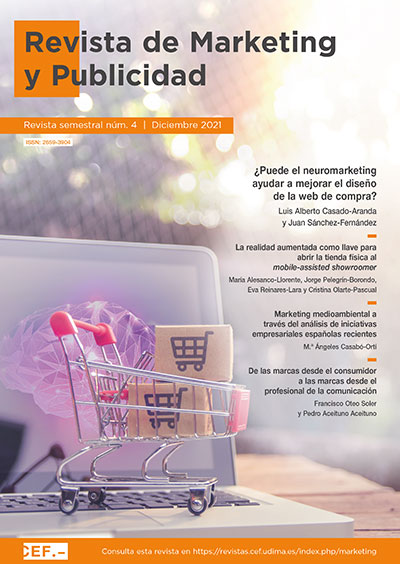La realidad aumentada como llave para abrir la tienda física al "mobile-assisted showroomer": ¿presente o futuro del "retail"?
DOI:
https://doi.org/10.51302/marketing.2021.802Palabras clave:
tienda física, teléfono móvil, realidad aumentada móvil, proceso de compra, modelo CAN, consumidor asistido por teléfono móvilResumen
Este trabajo ha obtenido un accésit del Premio Estudios Financieros 2021 en la modalidad de Marketing y Publicidad.
Desde la perspectiva tecnológica, la crisis covid-19 ha supuesto para el retail: (a) la aceleración de la transformación digital del comercio físico con la incorporación de tecnologías interactivas, como la realidad aumentada móvil (RAM), y (b) la transformación del shopping journey de sus clientes, en particular, los mobile-assisted showroomers (MAS). Con el objetivo de examinar de manera conjunta la tecnología del cliente MAS (smartphone) y la tecnología de la tienda (RAM), se propone y contrasta un modelo teórico cognitivo-afectivo-normativo sobre una muestra de 805 consumidores MAS que explique su intención de uso de la RAM in-store, considerando el papel moderador del género. Los resultados muestran que la «expectativa de rendimiento» se revela como el mayor antecedente para ambos grupos, aunque existe un efecto moderador del género, dada la mayor capacidad explicativa y predictiva del modelo de hombres MAS (R2 = 56,1 %) frente al modelo de mujeres MAS (R2 = 51,3 %). Sorprendentemente, el «esfuerzo esperado» es determinante en la valoración de los hombres MAS, cuando en la literatura ha sido relacionado con las mujeres. La «influencia social» se revela como el segundo factor en los antecedentes del segmento femenino. Estos resultados tienen implicaciones teóricas en el ámbito de la modelización e implicaciones prácticas para reactivar el sector del retail físico.
Descargas
Citas
Alesanco-Llorente, M., Reinares-Lara, E., Olarte-Pascual, C. y Pelegrín-Borondo, J. (2021). Mobile-assisted-showroomer: modelo cognitive-afectivo-normativo-conativo de comportamiento en la tienda física de moda (No. 2101). Catedra Fundación Ramón Areces de Distribución Comercial.
Ameen, N., Tarhini, A., Shah, M. H. y Madichie, N. O. (2020). Employees’ behavioural intention to smartphone security: A gender-based, cross-national study. Computers in Human Behavior, 104, 106184.
Azuma, R., Baillot, Y., Behringer, R., Feiner, S., Julier, S. y MacIntyre, B. (2001). Recent advances in augmented reality. IEEE Computer Graphics and Applications, 21(6), 34-47.
Berman, B. (2019). Flatlined: Combatting the death of retail stores. Business Horizons, 62(1), 75-82.
Blaise, R., Halloran, M. y Muchnick, M. (2018). Mobile commerce competitive advantage: A quantitative study of variables that predict m-commerce purchase intentions. Journal of Internet Commerce, 17(2), 96-114.
Bonetti, F., Warnaby, G. y Quinn, L. (2018). Augmented reality and virtual reality in physical and online retailing: A review, synthesis and research agenda. En Augmented reality and virtual reality (pp. 119-132). Springer, Cham.
Brengman, M., Willems, K. y Van Kerrebroeck, H. (2019). Can’t touch this: the impact of augmented reality versus touch and non-touch interfaces on perceived ownership. Virtual Reality, 23(3), 269-280.
Caboni, F. y Hagberg, J. (2019). Augmented reality in retailing: a review of features, applications and value. International Journal of Retail & Distribution Management, 47(11), 1125-1140.
Capgemini. (2020). The consumer and COVID-19: Global consumer sentiment research in the consumer products and retail industry. https://www.capgemini.com/es-es/wpcontent/uploads/sites/16/2020/04/Covid-19-Consumer-Behaviour-in-CPR-13.pdf
Dacko, S. G. (2017). Enabling smart retail settings via mobile augmented reality shopping apps. Technological Forecasting and Social Change, 124, 243-256.
Ditendria. (2019). Mobile en España y en el Mundo. https://n9.cl/5xjlu
Do, H. N., Shih, W. y Ha, Q. A. (2020). Effects of mobile augmented reality apps on impulse buying behavior: An investigation in the tourism field. Heliyon, 6(8), e04667.
Fassnacht, M., Beatty, S. E. y Szajna, M. (2019). Combating the negative effects of showrooming: Successful salesperson tactics for converting showroomers into buyers. Journal of Business Research, 102, 131-139.
Fiestas, J. C. y Tuzovic, S. (2021). Mobile-assisted showroomers: Understanding their purchase journey and personalities. Journal of Retailing and Consumer Services, 58, 102280.
Flavián, C., Ibáñez-Sánchez, S. y Orús, C. (2019). The impact of virtual, augmented and mixed reality technologies on the customer experience. Journal of Business Research, 100, 547-560.
García-Milon, A., Juaneda-Ayensa, E., Olarte-Pascual, C. y Pelegrín-Borondo, J. (2020). Towards the smart tourism destination: Key factors in information source use on the tourist shopping journey. Tourism Management Perspectives, 36, 100730.
Gensler, S., Neslin, S.A. y Verhoef, P. C. (2017). The showrooming phenomenon: It’s more than just about price. Journal of Interactive Marketing, 38, 29-43.
Giovanis, A., Assimakopoulos, C. y Sarmaniotis, C. (2019). Adoption of mobile self-service retail banking technologies. International Journal of Retail & Distribution Management, 47(9), 894-914.
Holdack, E., Lurie-Stoyanov, K. y Fromme, H. F. (2020). The role of perceived enjoyment and perceived informativeness in assessing the acceptance of AR wearables. Journal of Retailing and Consumer Services, 102259.
iVend Retail. (2019). Global Shopper Trends Report. https://support.ivend.com/userportal?id=doc_view&doc=KB0011245
Kim, H. Y., Lee, J. Y., Mun, J. M. y Johnson, K. K. (2017). Consumer adoption of smart in-store technology: assessing the predictive value of attitude versus beliefs in the technology acceptance model. International Journal of Fashion Design, Technology and Education, 10(1), 26-36.
Koo, D. M. y Ju, S. H. (2010). The interactional effects of atmospherics and perceptual curiosity on emotions and online shopping intention. Computers in Human Behavior, 26(3), 377-388.
Kourouthanassis, P., Boletsis, C., Bardaki, C. y Chasanidou, D. (2015). Tourists responses to mobile augmented reality travel guides: The role of emotions on adoption behavior. Pervasive and Mobile Computing, 18, 71-87.
Lee, H. y Leonas, K. (2018). Consumer experiences, the key to survive in an omni-channel environment: use of virtual technology. Journal of Textile and Apparel, Technology and Management, 10(3).
Lim, X. J., Cheah, J. H., Ng, S. I., Basha, N. K. y Liu, Y. (2021). Are men from Mars, women from Venus? Examining gender differences towards continuous use intention of branded apps. Journal of Retailing and Consumer Services, 60, 102422.
McLean, G. y Wilson, A. (2019). Shopping in the digital world: Examining customer engagement through augmented reality mobile applications. Computers in Human Behavior, 101, 210-224.
Mosquera, A., Juaneda-Ayensa, E., Olarte-Pascual, C. y Pelegrín-Borondo, J. (2018). Key factors for in- store smartphone use in an omnichannel experience: millennials vs. nonmillennials. Complexity, 2018, article ID 1057356.
Natarajan, T., Balasubramanian, S. A. y Kasilingam, D. L. (2017). Understanding the intention to use mobile shopping applications and its influence on price sensitivity. Journal of Retailing and Consumer Services, 37, 8-22.
Olarte-Pascual, C., Reinares-Lara, E., Pelegrín-Borondo, J. y Alesanco-Llorente, M. (2021). Plan Parcial Estratégico del comercio de Logroño, 2021-2025. Cátedra extraordinaria de Comercio de la Universidad de La Rioja y el Ayuntamiento de Logroño.
Pantano, E. y Priporas, C. V. (2016). The effect of mobile retailing on consumers’ purchasing experiences: A dynamic perspective. Computers in Human Behavior, 61, 548-555.
Paulo, M. M., Rita, P., Oliveira, T. y Moro, S. (2018). Understanding mobile augmented reality adoption in a consumer context. Journal of Hospitality and Tourism Technology, 9(2), 142-157.
Pelegrín-Borondo, J., Reinares-Lara, E. y Olarte-Pascual, C. (2018). Do you want to be a cyborg? The moderating effect of ethics on neural implant acceptance. Computers in Human Behavior, 85, 43-53.
Poushneh, A. (2018). Augmented reality in retail: A trade-off between user’s control of access to personal information and augmentation quality. Journal of Retailing and Consumer Services, 41, 169-176.
PwC. (2019). Seeing is believing. How virtual reality and augmented reality are transforming business and the economy. https://www.pwc.es/es/publicaciones/tecnologia/assets/seeing-is-believing-informe-pwc.pdf
Qin, H., Peak, D. A. y Prybutok, V. (2021). A virtual market in your pocket: How does mobile augmented reality (MAR) influence consumer decision making? Journal of Retailing and Consumer Services, 58, 102337.
Reinares-Lara, E., Olarte-Pascual, C. y Pelegrín-Borondo, J. (2018). Do you want to be a cyborg? The moderating effect of ethics on neural implant acceptance. Computers in Human Behavior, 85, 43-53.
Saprikis, V., Avlogiaris, G. y Katarachia, A. (2021). Determinants of the intention to adopt mobile augmented reality apps in shopping malls among university students. Journal of Theoretical and Applied Electronic Commerce Research, 16(3), 491-512.
Shao, Z., Zhang, L., Li, X. y Guo, Y. (2019). Antecedents of trust and continuance intention in mobile payment platforms: The moderating effect of gender. Electronic Commerce Research and Applications, 33, 100823.
Venkatesh, V., Thong, J. y Xu, X. (2012). Consumer acceptance and use of information technology: extending the unified theory of acceptance and use of technology. MIS Q., 36, pp. 157-178.
Viejo-Fernández, N. (2021). Retail y tecnología, la pareja perfecta. Brazilian Journal of Business, 3(1), 517-536.
Viejo-Fernández, N., Sanzo-Pérez, M. J. y Vázquez-Casielles, R. (2020). Is showrooming really so terrible? Start understanding showroomers. Journal of Retailing and Consumer Services, 54, 102048.
Wang, H. Y. y Wang, S. H. (2010). User acceptance of mobile internet based on the unified theory of acceptance and use of technology: Investigating the determinants and gender differences. Social Behavior and Personality: An International journal, 38(3), 415-426.
Yuan, S., Liu, Y., Yao, R. y Liu, J. (2016). An investigation of users’ continuance intention towards mobile banking in China. Information Development, 32(1), 20-34.
Descargas
Publicado
Cómo citar
Número
Sección
Licencia
Derechos de autor 2022 María Alesanco-Llorente, Jorge Pelegrín-Borondo, Eva Reinares-Lara, Cristina Olarte-Pascual

Esta obra está bajo una licencia internacional Creative Commons Atribución-NoComercial-SinDerivadas 4.0.





















